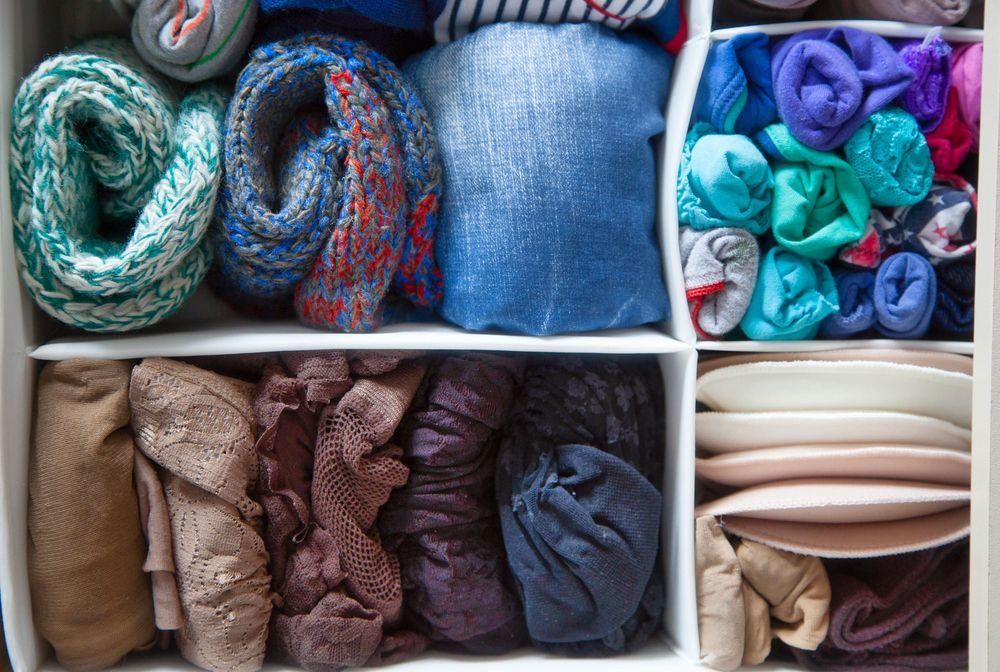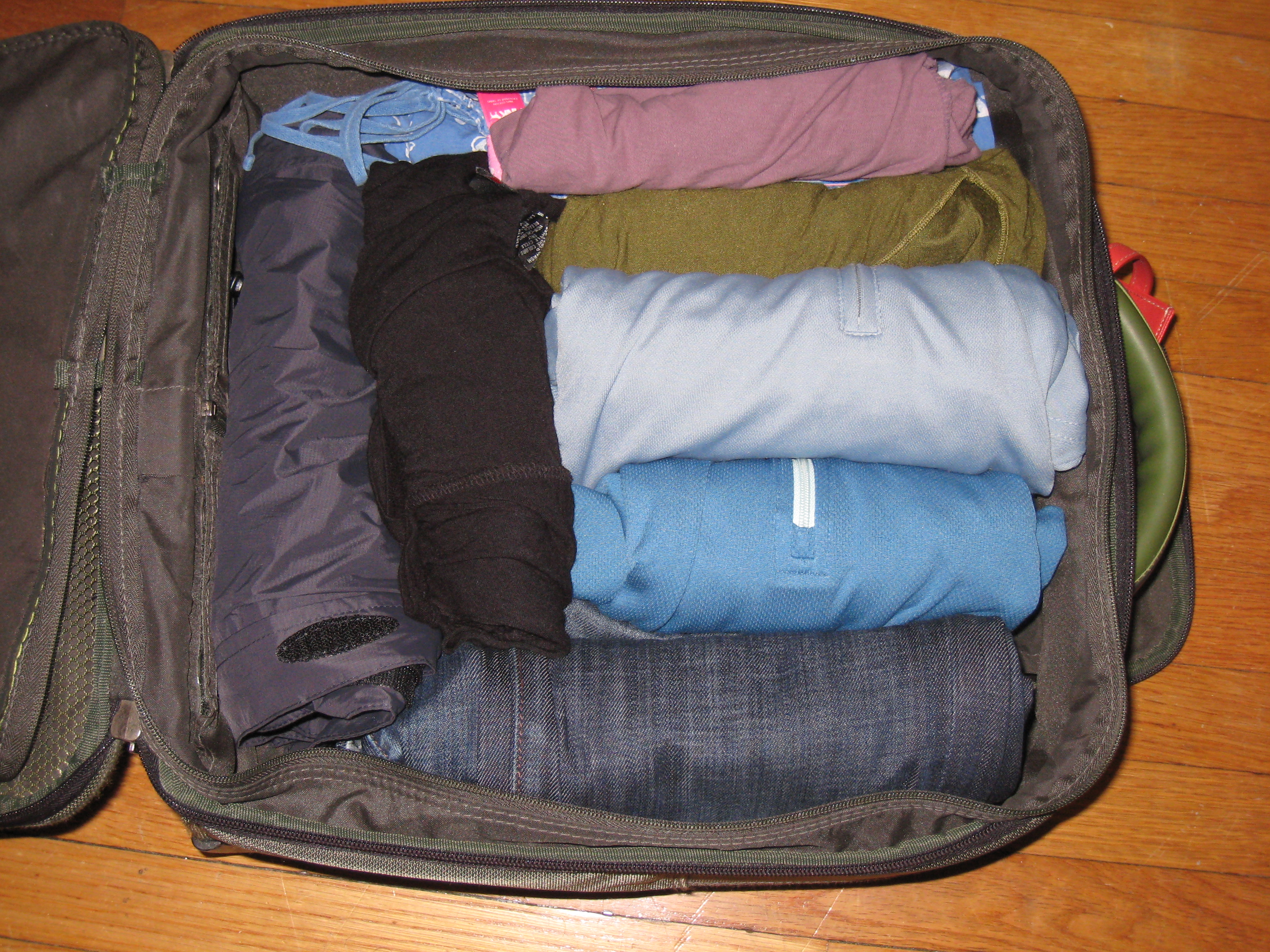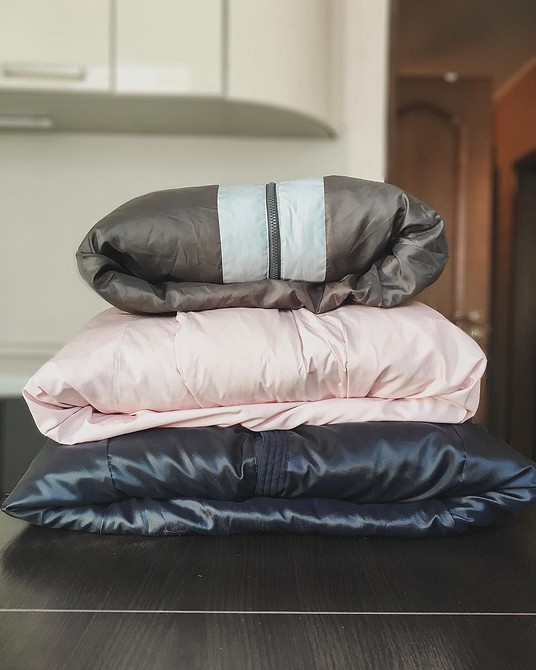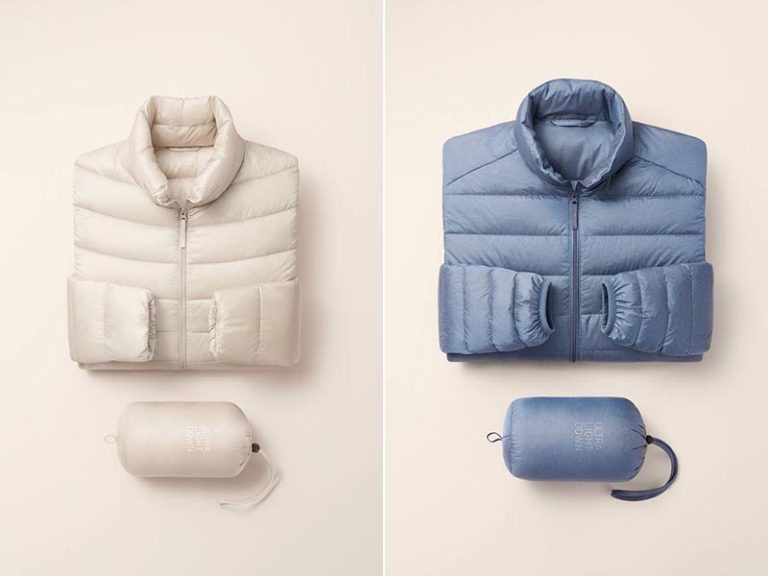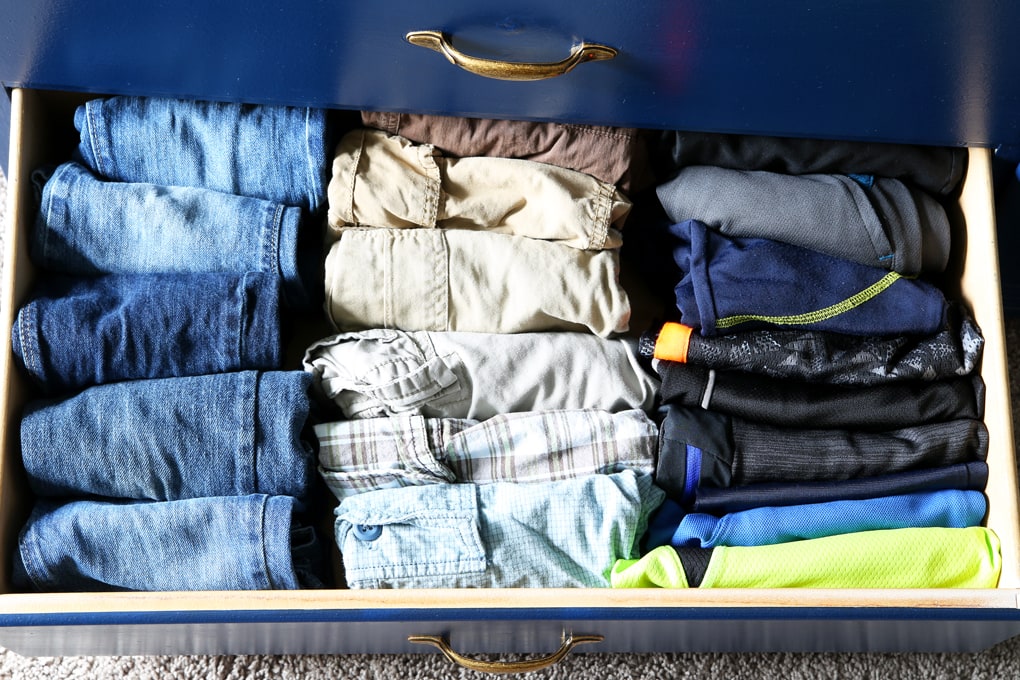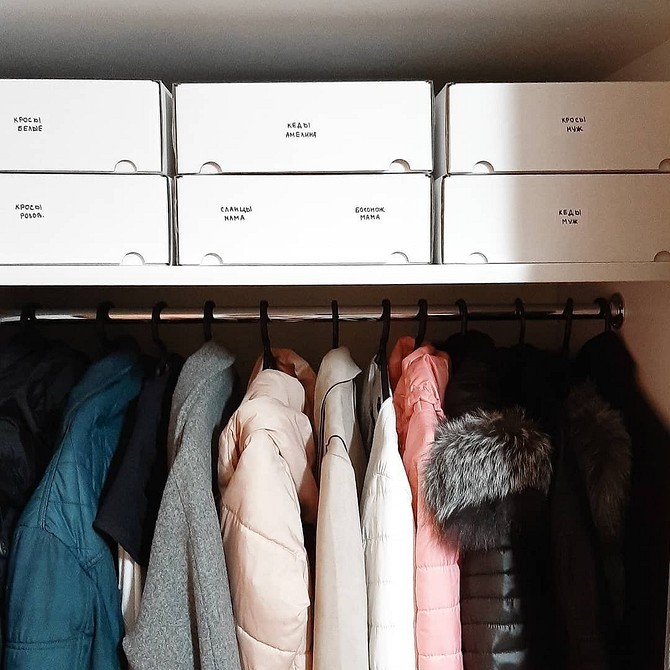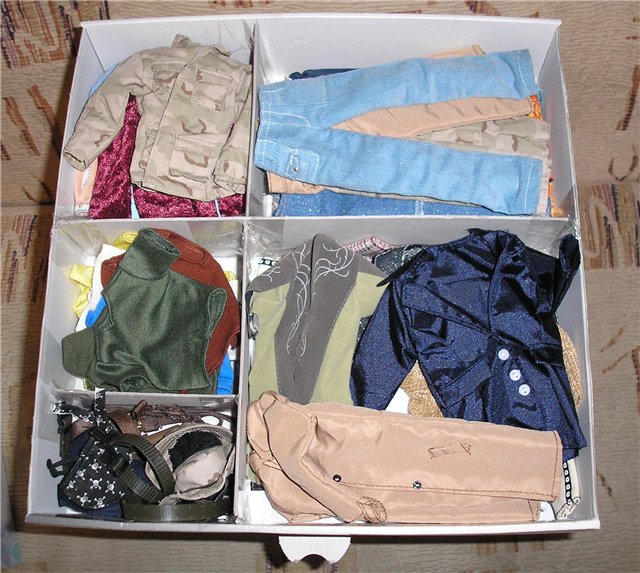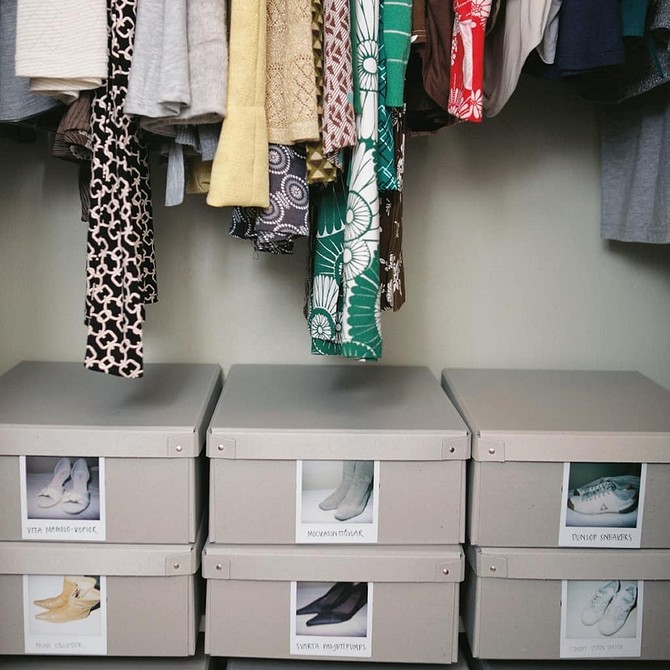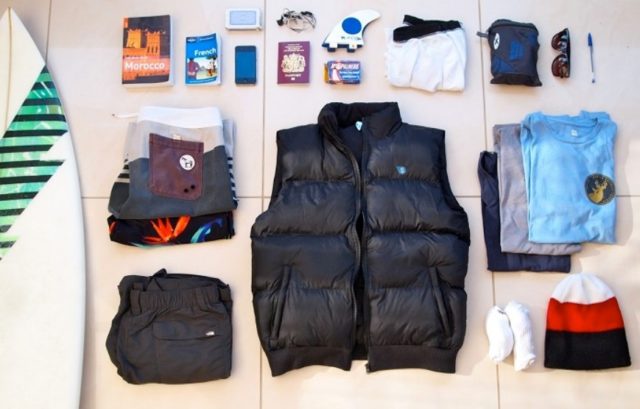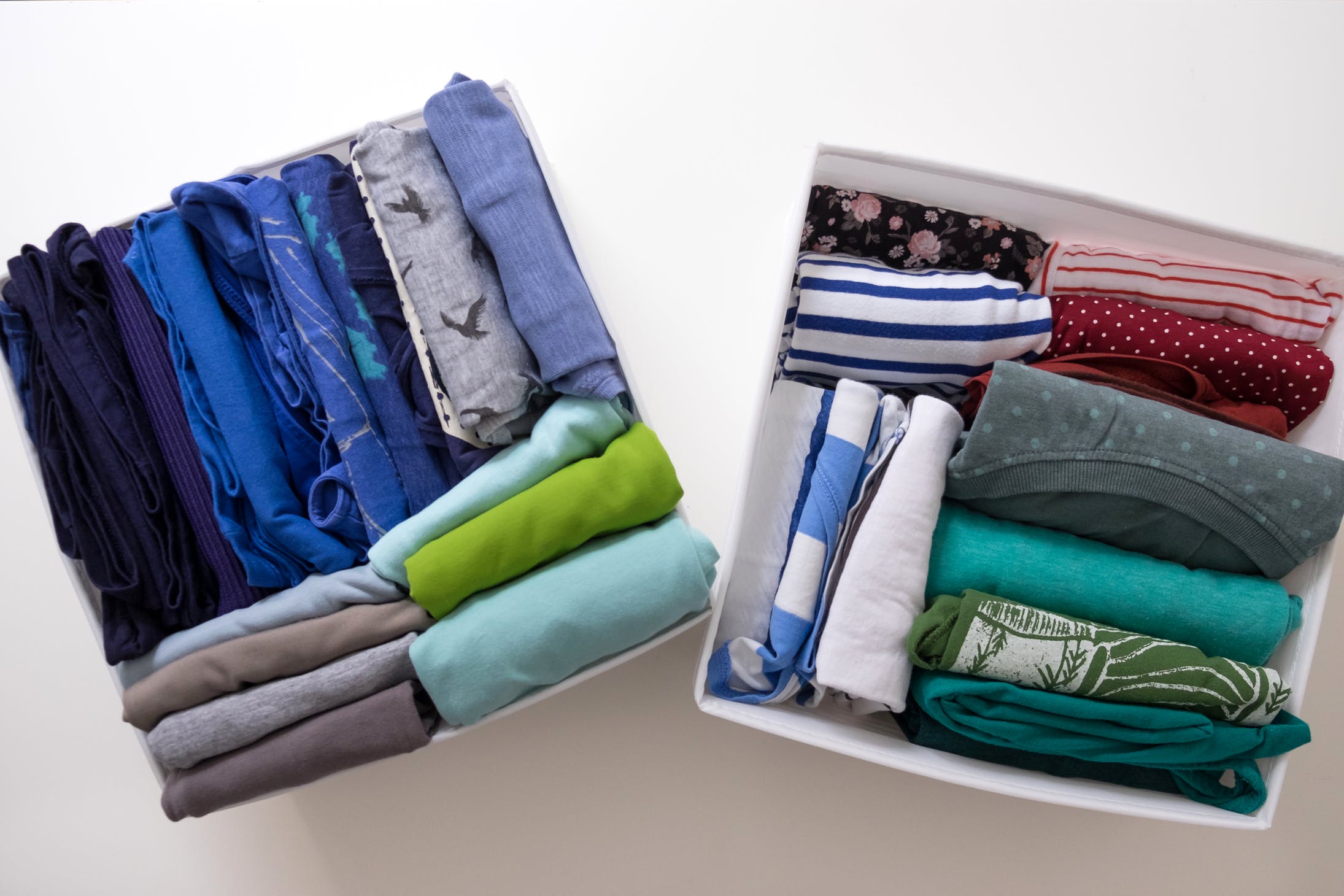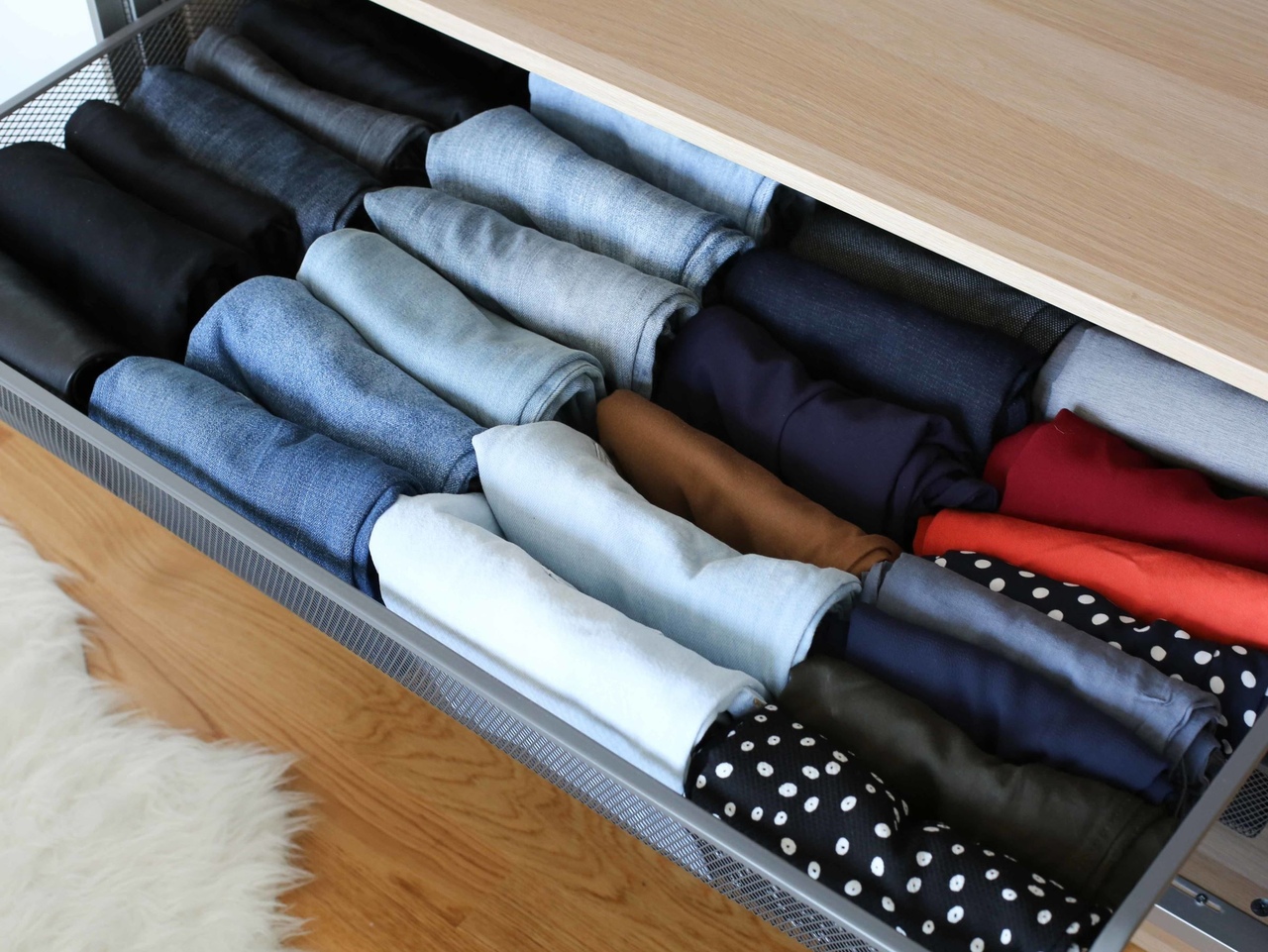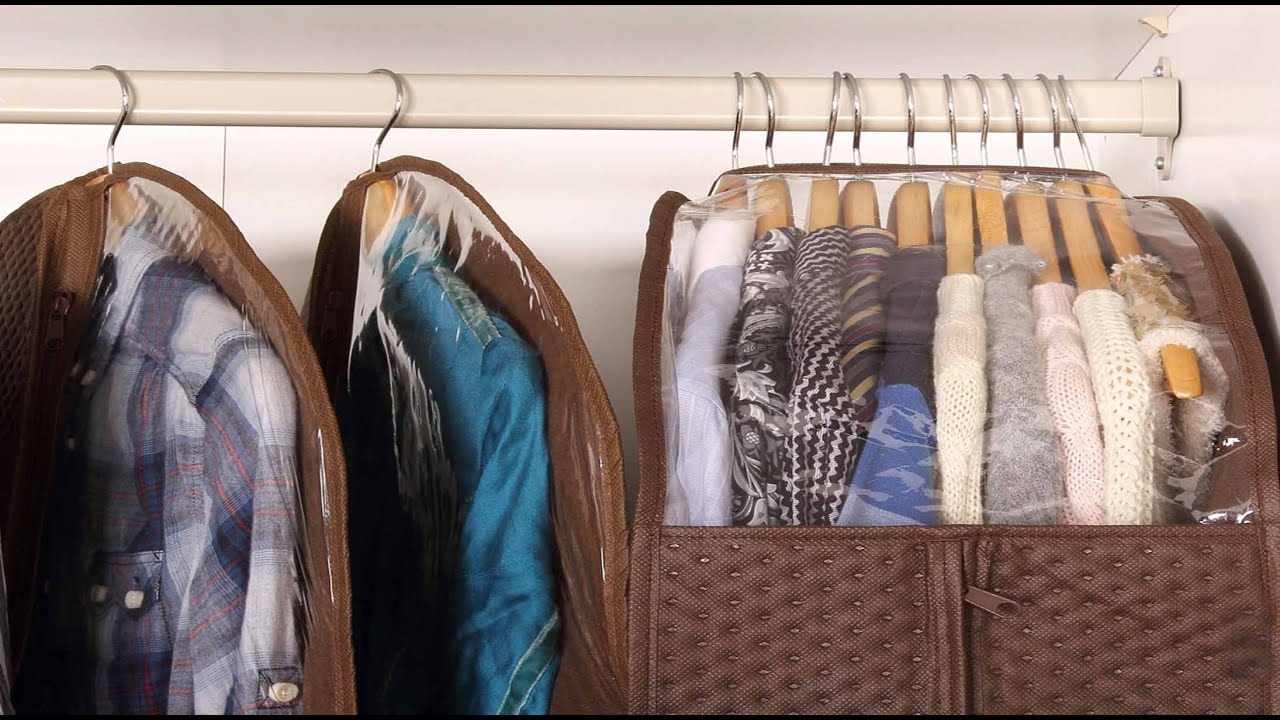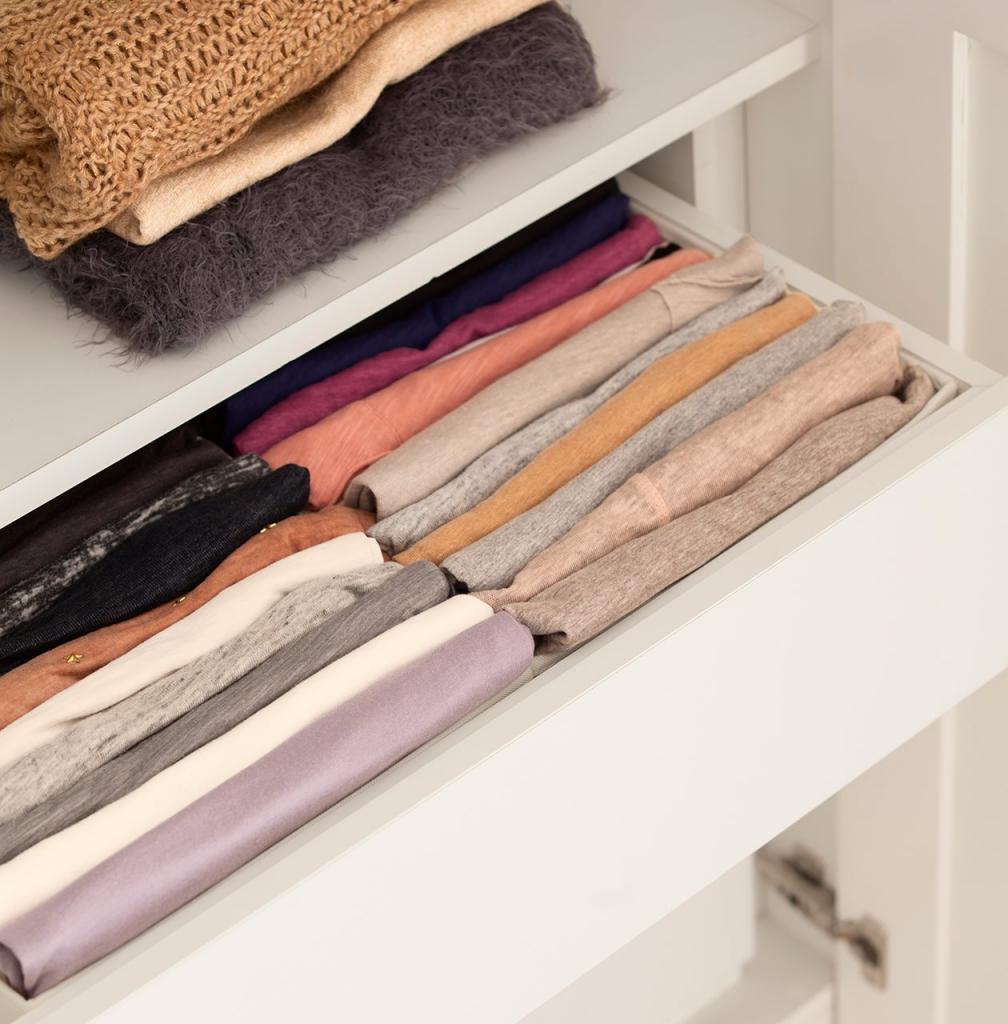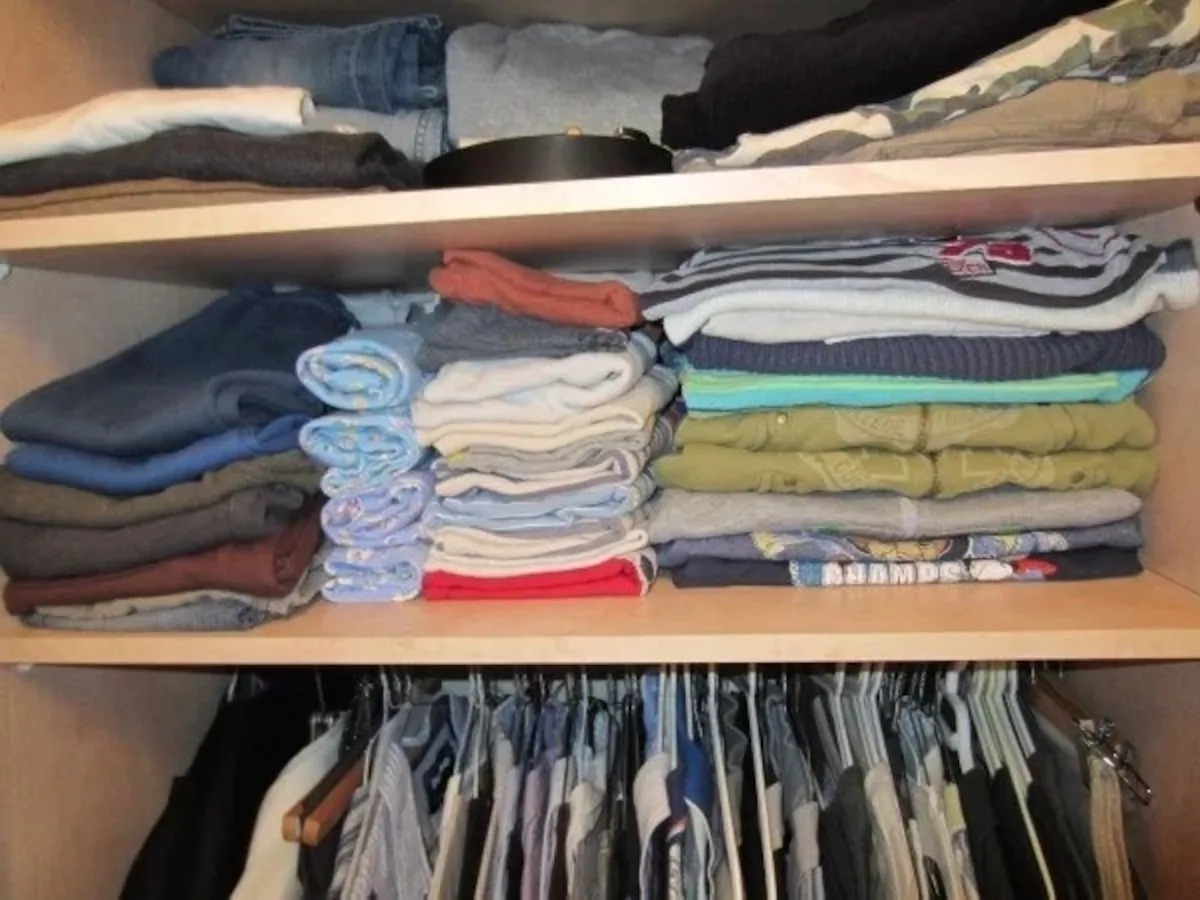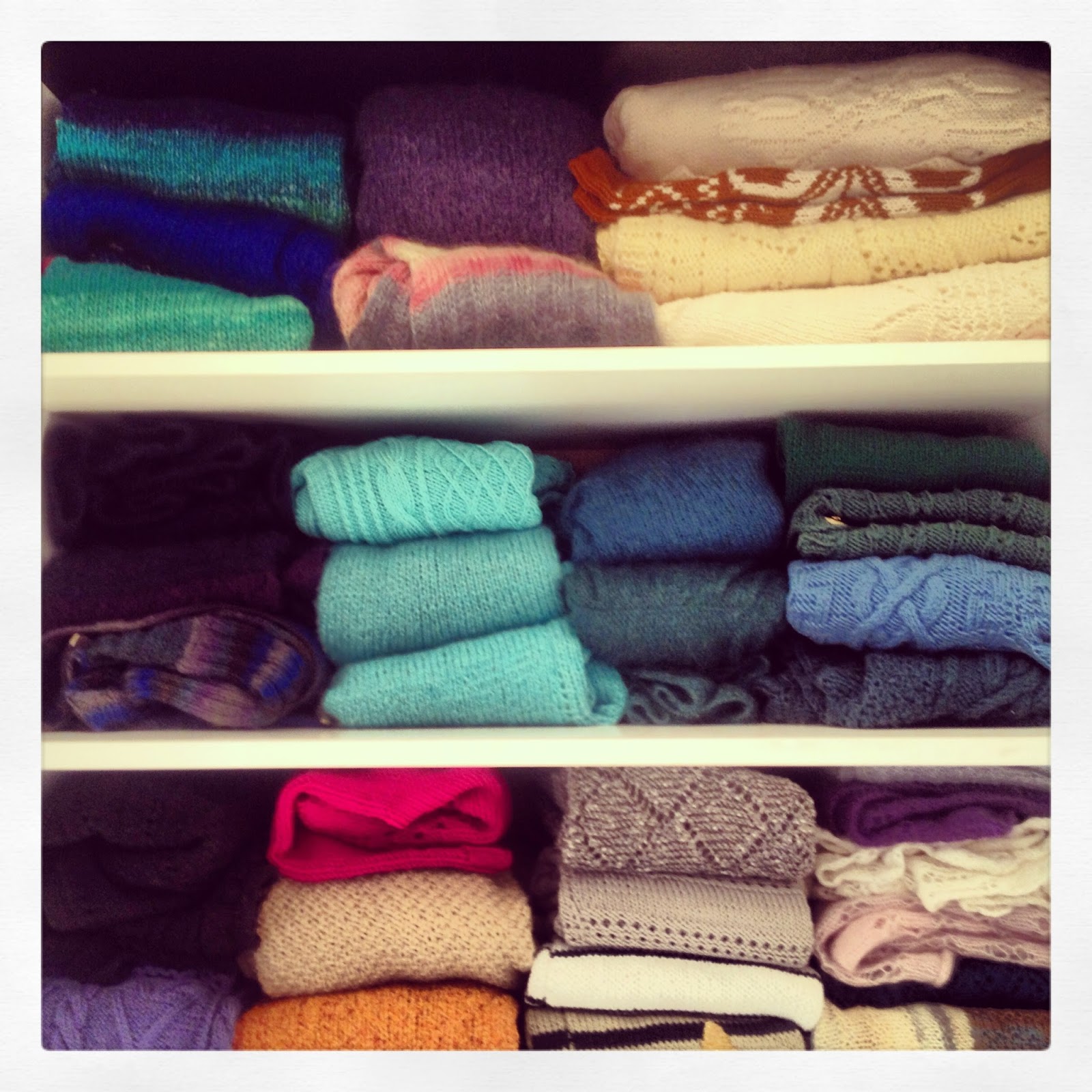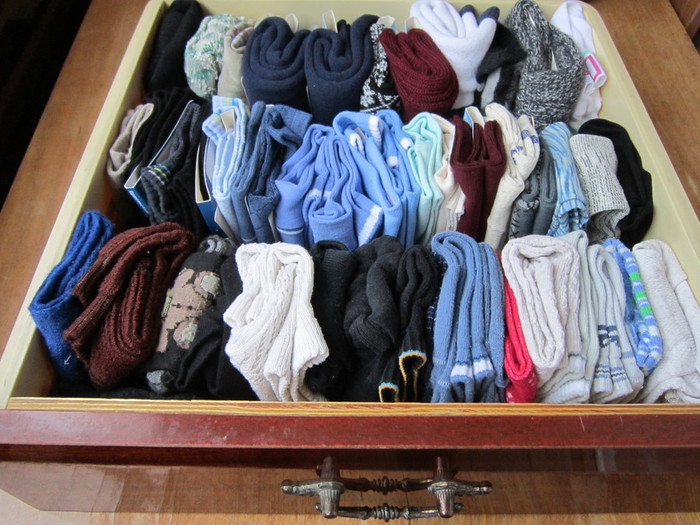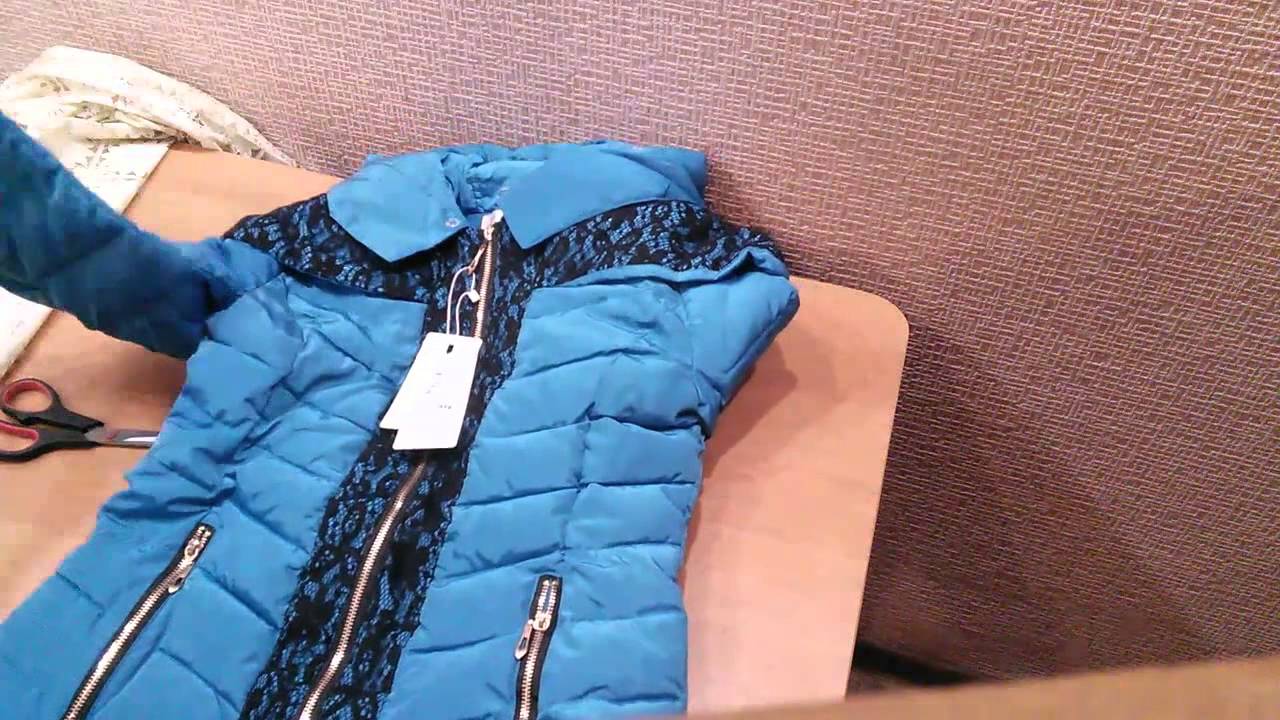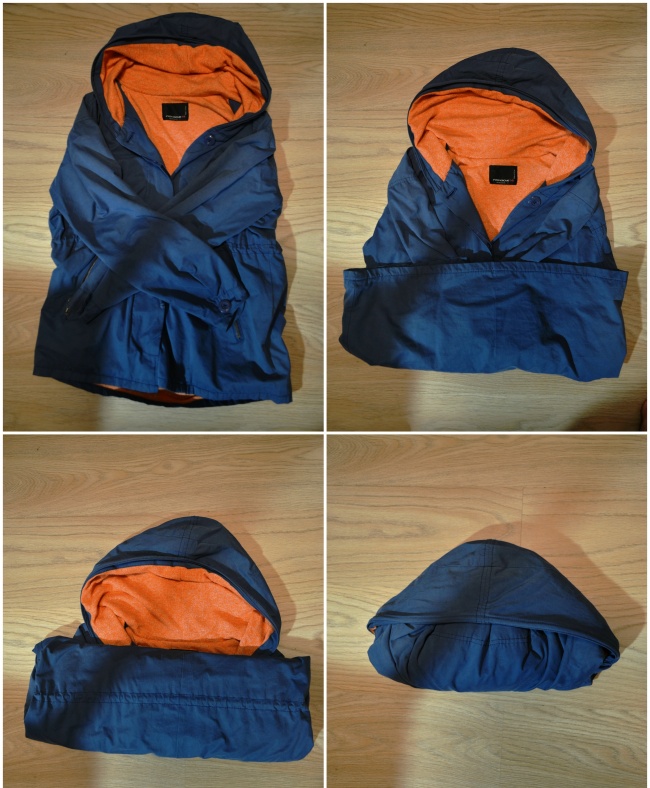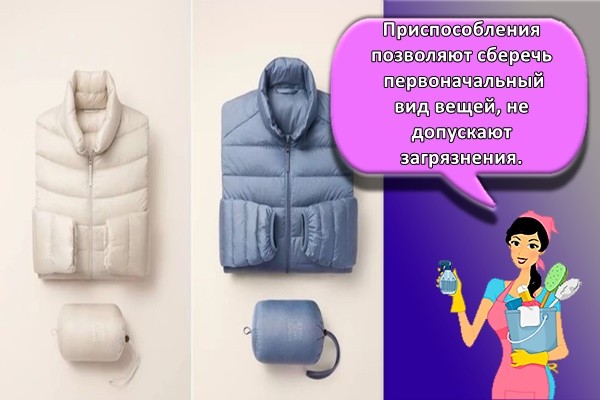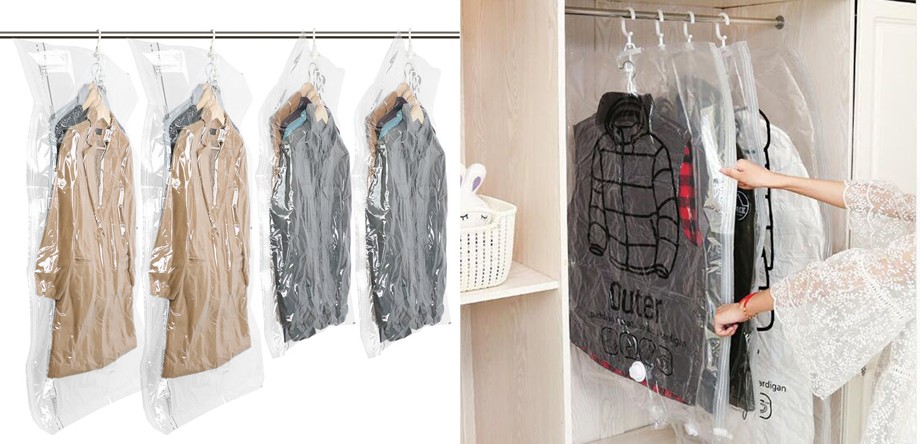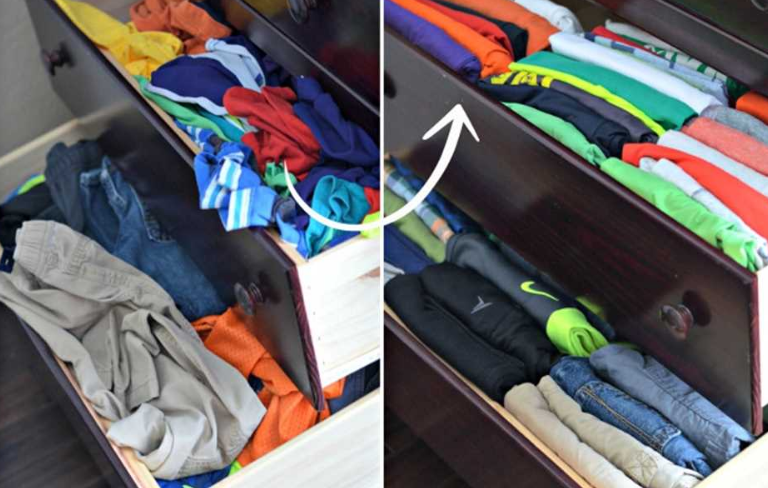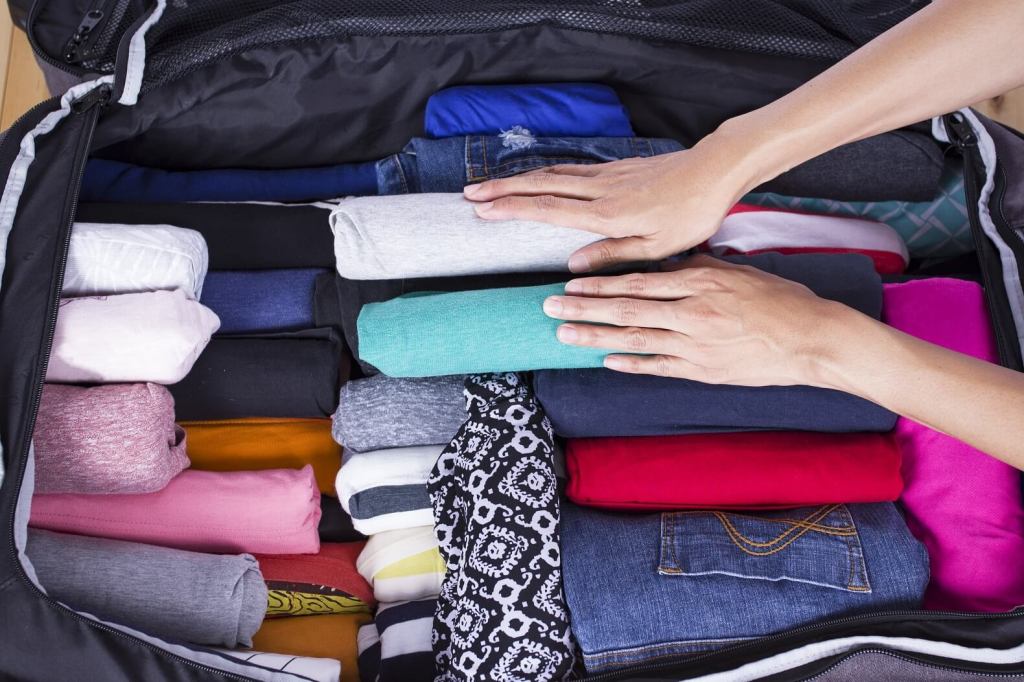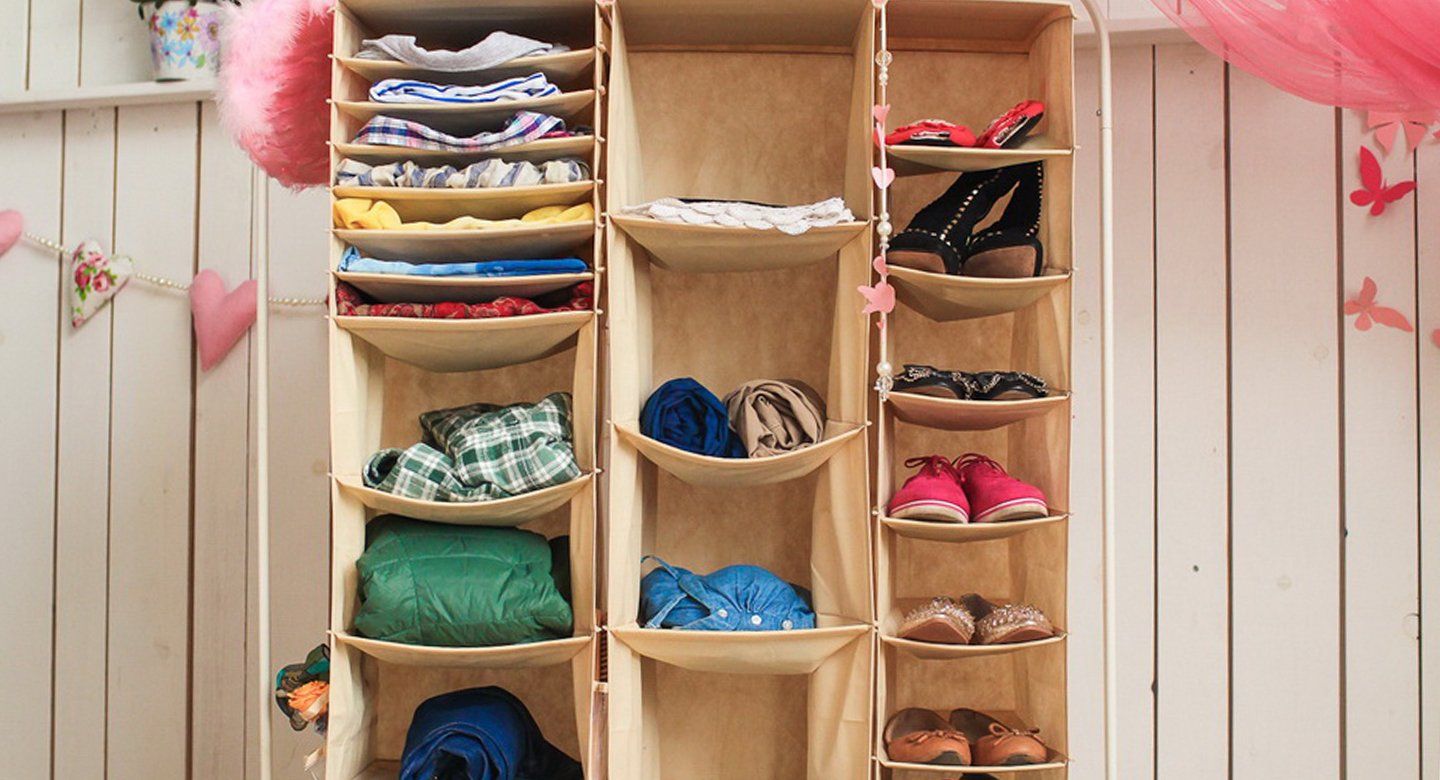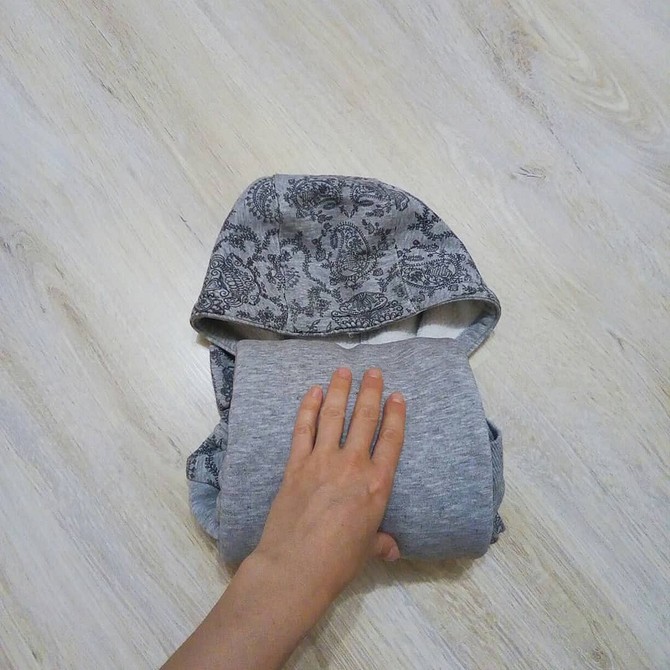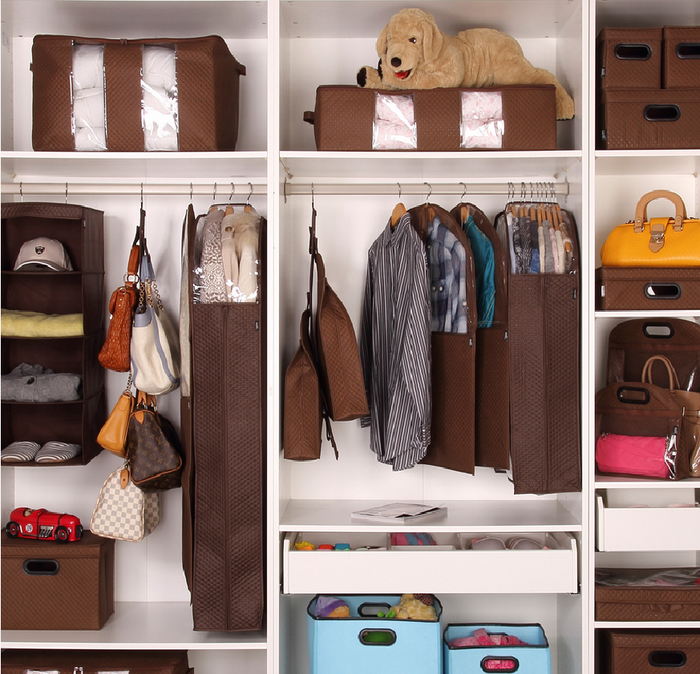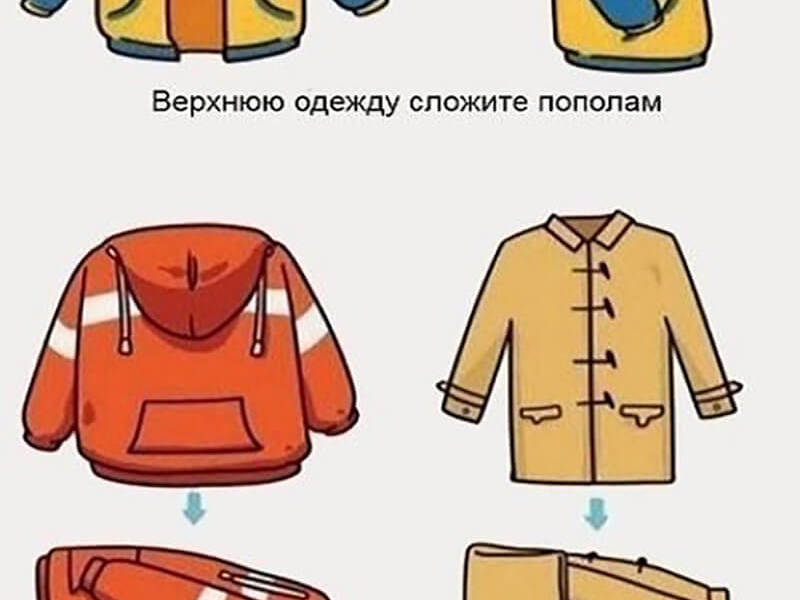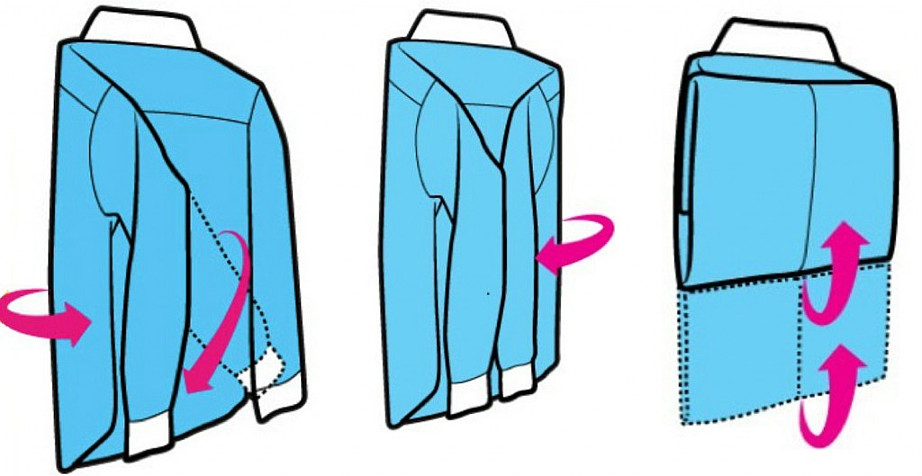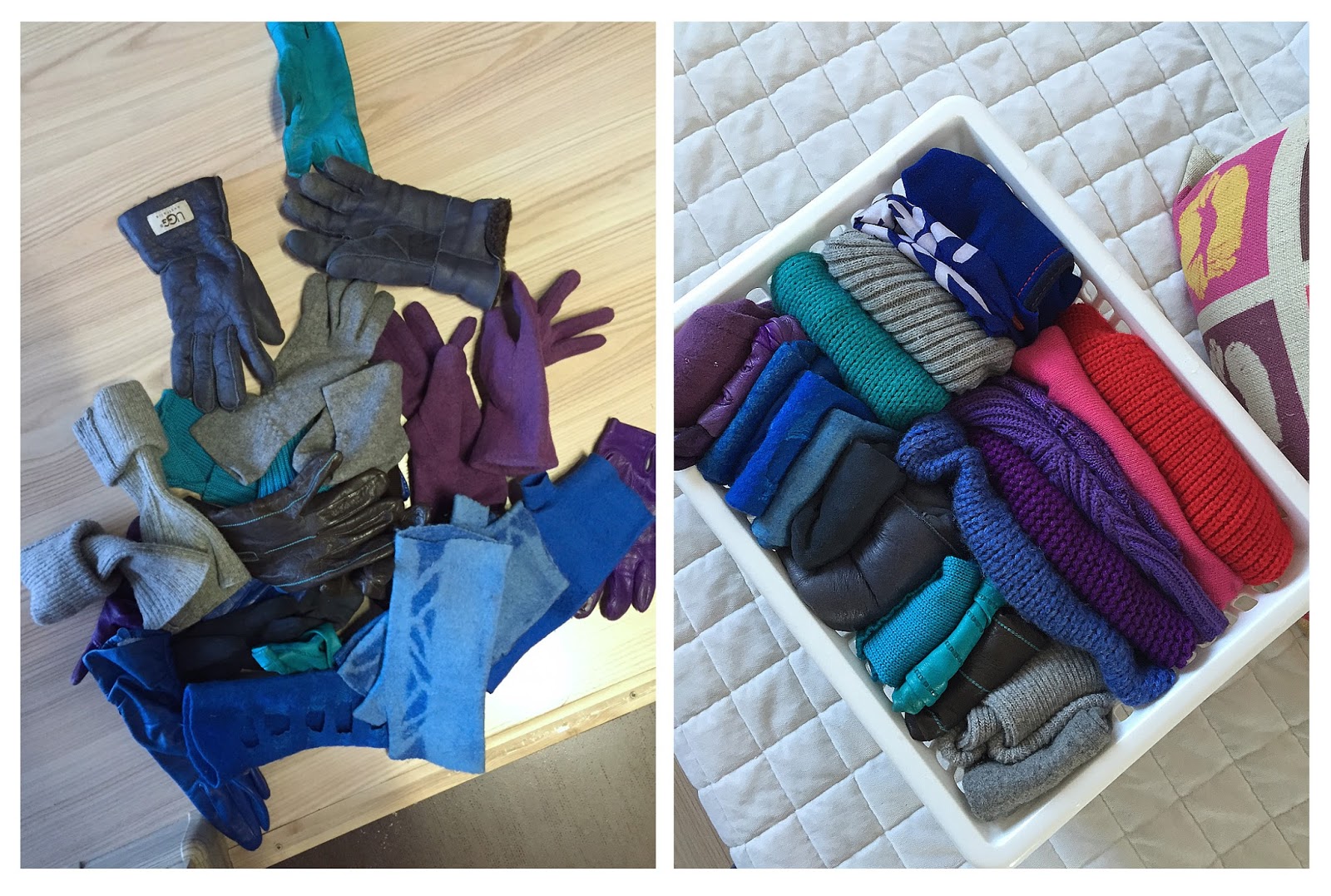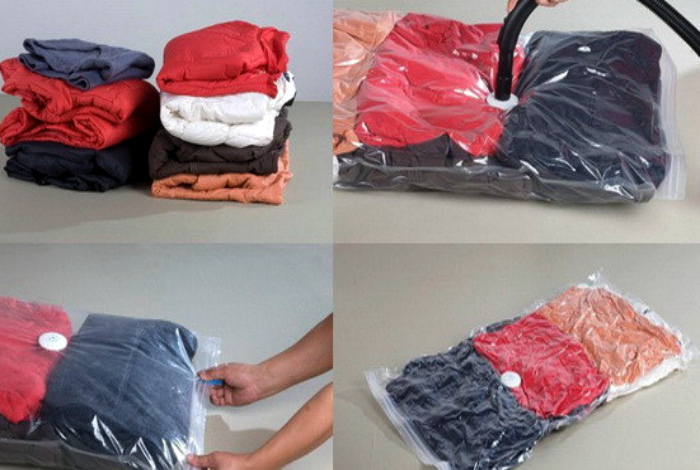What we have - we take care
While there is a difference in how to store light skirts and T-shirts or fall jackets, there are basic rules to help preserve the look of long-term cleaned items.
Before packing the outfits of the outgoing season, clean them of any traces of use. Dry-clean jackets, hats, coats, down jackets and other outerwear, wash the rest and dry thoroughly.
Ventilate cabinets and dressers every two weeks, but do not expose them to bright light, especially sunlight. At this time, remove pets from the rooms: no matter how touching the cats that fall asleep on a pile of sweaters, the traces left by them will please very few people.
Using plastic containers or trunks will help keep your clothes compact, protecting them from pests and dust. They facilitate sorting and are simply indispensable in cabinets with deep shelves, where otherwise there is a mess from mixing stacks from the first and second rows. Heavy items are always placed at the bottom, while light and fluffy items occupy the top of a shelf or box. This is how they store clothes made of thin fabrics that can stretch for several weeks of immobility.
Everything that loses its shape when folded is hung in the wardrobe.
You need to pay attention to the size of the hangers so that the clothes do not slip off too small ones and do not stretch too large shoulders. Ideally, each item should be hung separately, as a last resort, you can hang lighter shirts on top of heavy ones.
In addition to protection against distortion of the shape, you need to think about protection from dust and moths.
You can put on a cotton shirt or cover them with a special plastic bag on jackets or windbreakers. When choosing how to store a down jacket, leather jacket or fur coat, give preference to linen or paper covers. Plastic is not suitable here, as natural materials must "breathe". Vacuum bags for clothes save space, but hopelessly spoil the fur and leave creases on the skin, and it is very difficult to restore the air gap in the crumpled filler of a down coat.
The foul-smelling naphthalene and dangerous for children and animals have long been replaced by fragrant sachets. Frightens off moths and the smell of lavender or sage. Bunches of these herbs in the closet, bags with them in the drawers of the dresser, or cedar balls and sticks placed between clothes will save you from unexpected guests. When laying them out, you need to make sure that they do not come into contact with things directly, wrap them in tissue paper.
How to store fur and leather items
Fur products are extremely finicky and require special care. Ideally, fur coats made of natural fur - muton and mink - should be stored at temperatures from 0 to 10 degrees, but at home it is difficult to ensure such a temperature. Therefore, it is necessary to take a place for fur products in the built-in wardrobe on the loggia, where there is coolness and no moisture.
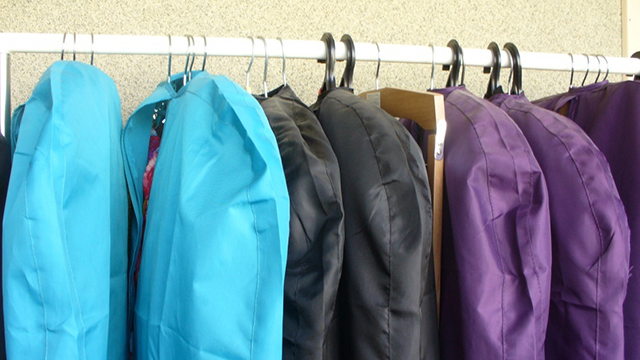
First, you need to prepare a fur coat or sheepskin coat for long-term storage, for example, dry-clean or clean the products yourself at home
Vacuum the fur, go over the fur coat with a special brush, then hang it on a wide (this is important) hanger (preferably made of natural wood)
After that, treat the fur with a moth repellent, especially pay attention to the area under the hood and on the cuffs of the sleeves. Store the fur coat in a fabric cover and hang it in a cool, dark place
For a pleasant scent, put a bag of lavender in your fur coat pocket.
Before packing, it is better to treat a sheepskin coat with a special care product for suede products, and a tampon soaked in a solution of 1 tsp will help to remove contamination. 9% vinegar per liter of water.After processing, the sheepskin coat should dry and ventilate. A cloth bag and a wide-handed hanger are also suitable for storage.
A hat made of natural fur must be cleaned and put on a rounded object so that it does not lose its shape. It can be a jar, a wooden block, or such coasters made of newspaper tubes.

If you don't have any of these, you can stuff the cap with paper.
Leather gloves should also be worn on a cut out of cardboard form so that they retain their previous appearance and do not get wrinkles and scuffs.
Step 1. Preparing products for storage
First of all, it is recommended to check all pockets and remove from them garbage accumulated over the winter, such as used transport tickets, candy wrappers, as well as forgotten handkerchiefs, gloves
etc. It is worth checking if all the buttons and rivets are in place, whether the zipper works well. In the event of a malfunction, everything is repaired, sewn and repaired.
In order to properly prepare any garment for storage, pay attention to labels, tags, which depict care symbols. In most cases, consumers do not know what certain care symbols mean:

In order to choose the right type of washing, dry cleaning, drying, ironing, anyone can use GOST ISO 3758-2014 “Textile products. Labeling with symbols for care ", which is freely available on the Internet, and see what this or that symbol for the care of the product means.

It is better to give natural sheepskin coats and fur products to a specialized dry cleaner, otherwise you can spoil the expensive material. However, you can also do cleaning at home. Fur collars, fur coats and other products are first cleaned with a brush. Stains and dirt can be removed with special products. If the products are dusty, they can be vacuumed.
After cleaning, such items are dried in a well-ventilated area. In this case, the outerwear must be hung on wide hangers that are suitable in size for this product.
Please note: home cleaning using folk methods, with inept actions, can ruin an expensive thing!
A down jacket and a winter jacket are easier to clean. Many products can be washed without problems in the washing machine (if the data on the label / sewn-in tag allows the use of a machine washable)
Beforehand, we recommend that you pay special attention to cuffs, collars and pockets, as these places become more dirty during the process of wearing. Choose a delicate setting and use special washing balls to keep the fluff or filler from getting tangled
After washing, carefully flatten your winter jacket or down jacket and dry your clothes in a well-ventilated area in a horizontal position. Straighten the product periodically, knead and distribute the filler.
It is undesirable to wash a coat containing wool. It is better to take such a product to a specialized dry cleaner.
Warm sweaters can also be washed in the washing machine on a delicate cycle using liquid detergents that are suitable for the type of material (do not forget to pay attention to the tags / labels with symbols for care). Most importantly, do not forget to use softening conditioner and set the temperature to 30 degrees.
But you can only wash cashmere products by hand!

Dry such products in a flattened form in a horizontal position. Be sure to dry all items thoroughly and spray them with moth spray before removing them.
As with the rest of your clothing, hats, scarves and gloves should be washed and dried well. But not all products of this type can be washed. Hats made of felt, wool and other materials that keep their shape easily wrinkle and lose this shape. Such hats are cleaned of dust with a clothes brush or a vacuum cleaner with a soft bristle attachment and dried well.

Rinse, clean and dry your shoes thoroughly before long-term storage. Use cloths, brushes, sponges, and products that are appropriate for the type of shoe material. Remember that leather, suede and nubuck, natural and artificial fur require different care. Check the products and take them to a workshop if necessary. Replace heels and repair heels, zipper if needed. You can paint over or remove scuffs, cracks and scratches at home using shoe paint or folk remedies.
Parting with the past
There are subtleties in storing summer or winter things, but you always need to start with a tough sorting. The stream of clothes escaping from the closet looks untidy. But at the same time things themselves quickly lose their shape and attractiveness. Therefore, at the end of the season, looking at your wardrobe, honestly answer the questions:
- will you wear these clothes in a year;
- whether you are wearing a stretched T-shirt;
- Will a sweater still be useful if you mend a hole in your sleeve? And will you begin to sew it up;
- the dress is hopelessly small, will you have time to lose weight before it goes out of fashion;
- Will you finally do the patchwork, or will this mountain of old shirts lie down for another year?
Anything that has not received a positive response, ruthlessly send aside, give it to someone or just throw it away. Some severity in dealing with the problem of "nothing to put on, nowhere to put" will be rewarded with free space for new clothes. This will help and better preserve the remaining things.
Rules for folding jackets made of various materials
When packing things in a suitcase or for long-term storage in a closet, it is imperative to take into account the material of the product. Things made of leather, fur coats, fur coats and sheepskin coats can especially suffer from improper storage. Down jackets are less capricious, but bruised marks can form on them, which will be difficult to remove.
How to fold a leather jacket
An expensive thing will last a long time and will not lose its original appearance only with proper care. Leather jackets are a status item of wardrobe, they are treated with a special cream, wiped, dried and carefully stored.
It is better not to fold or roll up a product made of genuine leather, since it does not form creases and dents. It is recommended to place the jacket in a fabric cover and hang it on a hanger in the corner of the cabinet. But sometimes the leather jacket needs to be folded compactly for transportation. The sequence of actions is something like this:
- Fasten the jacket with a zipper or buttons.
- Turn the product to the wrong side.
- Lay the sleeves crosswise on the back.
- Put the hood on top of the crossed sleeves.
- Roll the leather jacket as tightly as possible in the roller.
- Place the rolled item in a cloth bag to prevent it from getting dirty on the way.
Attention! If during the transportation the leather jacket is wrinkled, creases appear on the material, do not be upset, the thing can still be saved. Hang an expensive piece of clothing on a hanger in the bathroom and turn on the hot water flow
The steam and moisture will help flatten the leather jacket and restore its attractive appearance.
It is necessary to lay a bulky item compactly on a horizontal surface.
How to fold a synthetic jacket
It is recommended to fold warm winter clothes for storage in a closet in a rectangle - so they take up less space and free up space for summer clothes. The compact method assumes the following procedure:
- Lay the jacket on a flat surface facing away from you.
- Place the sleeves on the back and cover them with a hood if it does not come unfastened.
- Bend the product in half so that the bottom and top are on the same line.
- For reliability, secure the item of clothing with an elastic band and put it on the floor in the closet.
It is convenient to take thin down jackets or synthetic winter vests with you on the road. The thing is laid out on a flat surface, then turned over and the sides are folded towards each other.Next, the vest is folded four times and rolled into a compact roller.
How to compactly fold a denim jacket
A lightweight windbreaker made of versatile material should not be removed to the far shelves of the cabinet. This garment can be worn on cool summer evenings, warm spring or early fall. They wear a denim jacket even under a warm down jacket or coat.
You usually need to compactly pack a thing on the road, for a bag or suitcase. Step-by-step process of actions:
- Fasten the jacket with all buttons or zip.
- Lay on a horizontal surface with your back to you.
- Fold up the sleeves and fold them parallel to each other.
- Bend the bottom of the garment and align it along the top line, slightly bending the hem of the jacket inward.
Denim practically does not wrinkle, so you can fold the product to the very bottom of the suitcaseby placing other things on top of it. For transportation in a backpack, it is best to roll up a denim jacket with a thick roller.
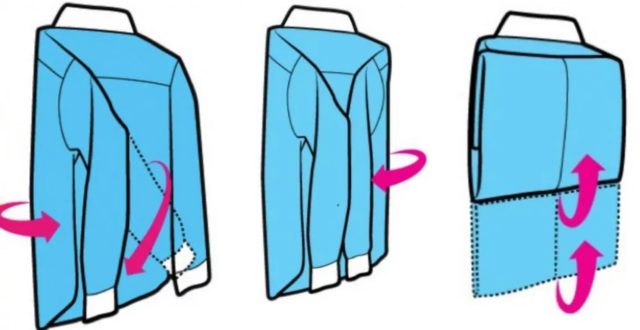 Compact fold denim jacket
Compact fold denim jacket
Features of storing jackets
In a large family, the lack of free space is especially acute. Each adult usually has 2-3 jackets per season, plus baby clothes that take up space no less than clothes for moms and dads. Before compactly folding the jackets for the winter, it is recommended to do the following manipulations:
- Check the general condition of the clothes: sew on torn buttons, fix broken locks, shake out small debris from pockets.
- Wash or dry clean jackets, dry thoroughly. It may be worth contacting a dry cleaner so as not to spoil expensive items made from delicate fabrics.
- It is best to try to sell or donate clothes that are damaged or inadequate in size, so as not to occupy free space in the house.
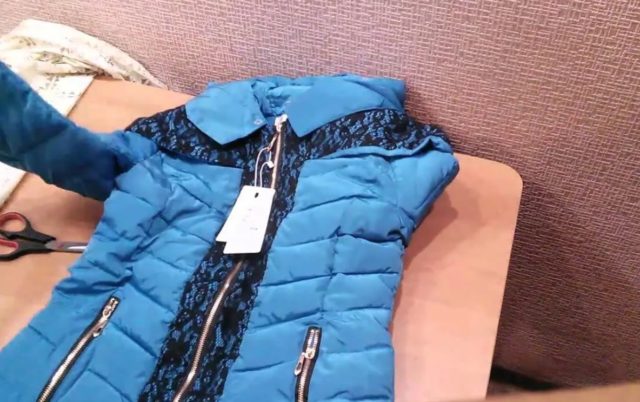 For long-term storage, the item must be absolutely clean and thoroughly dried.
For long-term storage, the item must be absolutely clean and thoroughly dried.
It is important not only to fold the jacket compactly for storage, but also to check the conditions in which it will be for several months. Fur items are afraid of moths and other pests; creases may appear on the skin from improper storage
Poorly dried fabric can cause mold to ruin the jacket.
Each material has its own storage characteristics:
- Natural fur jackets. It is best not to wash these clothes, but dry them. Treat the product with special products or aerosol from pests. Instead of poison, you can use natural cedar oil. It is best to store a fur coat or fur coat on a hanger in a fabric cover, which will provide air circulation and prevent the clothes from acquiring a musty smell.
- Leather things. Inside such jackets there is also natural fur, so the product should be treated from moths. There are special products that soften leather products and prevent the formation of creases on delicate materials.
- Bulky jackets and down jackets. Synthetic things do not have to be hung on a hanger and folded into a fabric cover; a simple bag from which you need to pump out the air will do.
You should learn how to fold jackets correctly so as not to spoil them and free up as much space as possible in your closet, bag or suitcase.
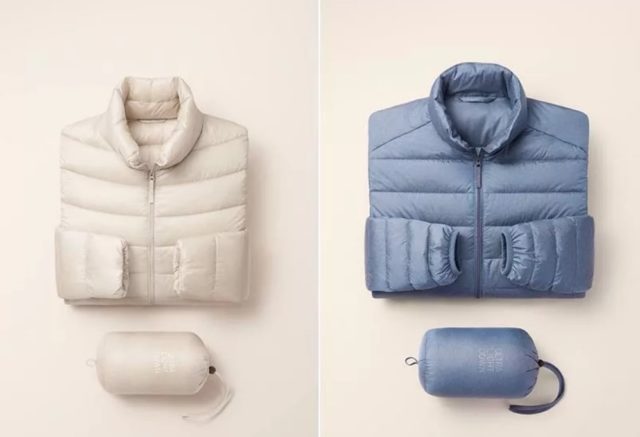 Storage of bulky items in vacuum bags
Storage of bulky items in vacuum bags
How to fold the jacket
The packaging techniques of the jacket, regardless of where the product is planned to be stored, will differ only if the outerwear is sewn from different materials. For example, for a down jacket this is one technique, but for leather it is completely different.
How to fold a winter jacket compact
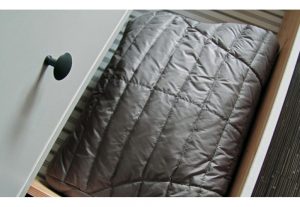
There are several ways to help keep your winter outerwear compact for off-season storage. Each of them is quite simple and convenient. They can be:
- roll into a roller;
- fold into a rectangle;
- put in a vacuum bag.
Roller
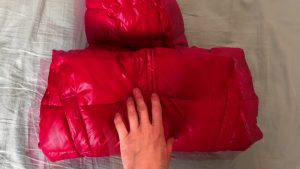
The easiest way is to gently roll the item into a roller. What is needed for this? Unfold the entire product on a flat surface. Close the locks.Turn inside out including sleeves. Next, straighten the garment to avoid the formation of deep creases. Then tuck the sleeves crosswise so that the cuffs are in the waist area. Now fold the jacket in half vertically, that is, fold in the middle (zipped). Starting from the bottom, roll the garment into a tight roller. To fix it in this form, you can use stationery rubber bands. If you don't want the dust to settle, put it in a natural fabric bag to allow air access.
Rectangle

Folding into a rectangle involves slightly different actions. This method is suitable if you are going to fold the product into a suitcase or a pull-out shelf in the closet.
In this case, it is very important that the rectangle is even. For this:
- spread the item on a flat, hard surface face down;
- tuck the sleeves along the side seams on the back;
- fold along the center;
- connect the lower part to the upper;
- fasten with an elastic band and pack.
Vacuum seal bags

But the use of vacuum bags is not suitable for every clothing. For example, it is undesirable to use this type of packaging if the jacket is made of leather or contains elements from it, has a fur edge. However, this method is quite convenient, since vacuum saves a lot of space.
This is quite important if storage space is limited. How to store a jacket in a vacuum bag? It is enough to fold the product in one of the ways described above, and then place it in polyethylene
Next, you need to tightly close the special fastener and use a vacuum cleaner or pump to draw out all the air using the valve.
How to fold a hooded jacket
 Folding a jacket that has a hood can sometimes be a hassle. And it's good if you can simply unfasten it, then there are no problems. But what if it is firmly sewn on? There is an exit! And he's pretty interesting. The jacket just needs to be folded ... into this same hood.
Folding a jacket that has a hood can sometimes be a hassle. And it's good if you can simply unfasten it, then there are no problems. But what if it is firmly sewn on? There is an exit! And he's pretty interesting. The jacket just needs to be folded ... into this same hood.
What is needed for this?
- close all zippers and turn the product inside out;
- sleeves must be folded one on top of the other;
- start rolling into a roller, starting from the bottom (make it as tight as possible);
- as soon as you reach the top, place the roller inside the hood, after straightening it.

Using this method, a rather small roll is obtained from a bulky down jacket, which fits perfectly on a shelf even in the smallest cabinet.
How to fold a denim jacket compact
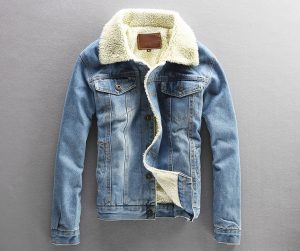
In fact, folding a thin jacket is much easier than it seems at first glance. Moreover, there is a rather simple way so that later it fits compactly either in a suitcase, or on a shelf in a closet.
To do this, you need to unfasten the buttons or zipper, turn the jacket with its back to you and, leaving it in the air, turn the sides towards you. Thus, the sleeves will remain inside you, and the product itself will be turned inside out. Then spread it out on a hard surface and align the seams. Now it remains only to fold vertically and wrap the bottom towards the top.
Application of covers and vacuum bags
Special devices for proper storage of things have become very popular among consumers. These are covers and vacuum bags. Their application is universal. Covers help:
- keep the shape and appearance of things;
- protect things from sunburn and damage;
- prevent dirt on clothes.

Separately, it should be said about vacuum bags. They are highly durable and, in addition to the qualities listed above, contribute to the compact storage of clothes. This is achieved by pumping out air from the inside of the bag through a special valve on its surface. In this case, the products inside are not wrinkled. Vacuum-packed jackets take up a minimum of space, saving a lot of cabinet space.
Skillfully organized storage will help preserve winter clothes and prolong their life for a long time.Applying in practice the methods of folding down jackets, warm and leather jackets, you can significantly improve the complete set and reduce to a minimum the workload of dressing rooms, wardrobes and suitcases.
It might be interesting
The ability to properly fold the sweater for storage or transportation of the product will allow you to keep its appearance, ...
The rules for how to fold the trousers directly depend on the material from which this item is made ...
Anyone who has had to pack can attest that the hardest thing is to fold a shirt so it doesn't ...
Seasonal clothes keep you warm during cold, rain and snow, but take up a lot of space in your closet and on hangers on hot days when not in use. If you fold the jacket compactly for the warm season, you can free up space for everyday things, ensuring comfort, cleanliness and order in the house.
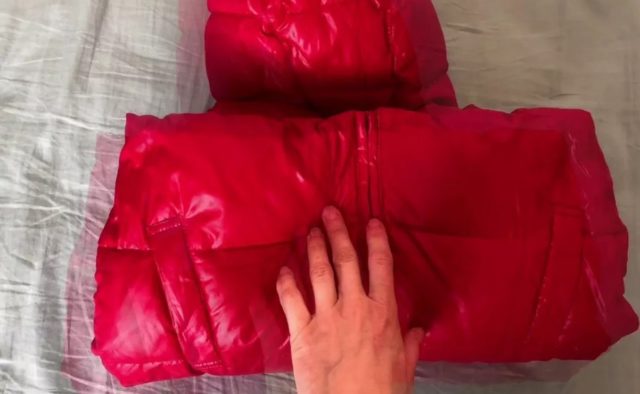
Step 2. Storage of products
Natural fur is capricious, it loves low temperatures and fresh air. Therefore, it is best to hand over fur products to a specialized store, and if this is not possible, store products suspended on wide hangers in a dark room, preferably in a spacious cabinet with tightly closed doors. Use a fabric or other special cover (but not polyethylene) for fur outerwear and periodically ventilate the garments on the balcony or loggia in dry weather, away from sunlight.

Store raincoats, coats, sheepskin coats, long warm dresses in the closet suspended, protecting them from dust with special fabric covers, selected in size (it is better not to use plastic ones - they will interfere with the flow of air, the product will eventually acquire a moldy smell). Make sure the hangers fit the garment and don't stretch your shoulders. Place things at least a couple of centimeters apart so as not to wrinkle them and not interfere with air circulation.
The down jacket for the summer can be folded and also put away in a special fabric cover. One of the storage options is in a vacuum bag, which will save space, but can crumple down and feathers, depriving the thing of volume. To avoid this, it is recommended to take out the down jacket from time to time and shake it well.
Other warm clothing. It needs to be sorted by materials and laid out so that the heavy one is at the bottom, and the lighter one is at the top. Piles can be stacked vertically in boxes and containers - this way things have less pressure and they hardly wrinkle. And it is better not to hang jersey on a hanger, as it will stretch.
For scarves, use special hangers on which you can hang several items made of silk, acrylic or fine fabric at once. A woolen or cashmere scarf for storage should be folded and stowed away in a drawer or cardboard box. Then it won't stretch.
Ordinary shoe boxes are perfect for storing hats and scarves; they can be signed and used instead of special containers. Fill the hats that keep their shape with paper inside, or use special coasters - as an option, you can use three-liter cans. Place the hats for storage in a cardboard box. These hats are not folded.
Gloves also fit perfectly into boxes such as shoes.
Shoes are best stored in cardboard boxes, or you can hang them on ordinary clip-on hangers. Place a textile bag of baking soda inside each half pair to keep the shoes dry. By the way, keep in mind that, for example, in ugg boots and similar shoes with natural sheep's wool, moths can easily start. Therefore, you need to put a moth repellent in the box with boots.
How to compactly fold a jacket into a suitcase
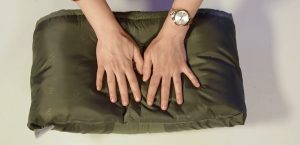
In this way, you can not only compactly fold the jacket not only into a suitcase, but also for off-season storage. What is needed for this:
- Close the zippers or buttons and place the front side towards you.
- Now turn the bottom of the product inside out by about 20 cm.
- The next ones are sleeves. We fold them along, one on top of the other. If there is a hood, then we also put it, that is, we wrap it down.
- Next, fold it in half. We press a little so that the air comes out. It is not necessary to apply too much pressure to the product. It is enough for it to "blow away" at least a little.
- The last stage - we carefully unfold the thing, and put on the part of the bottom, which was turned inside out, from above.
- Ready! Clothes are ready to be stored or transported.

Here are all the ways you can neatly fold your outerwear. Perhaps at first glance they will seem complicated, but if you practice, then the whole process will take you no more than 5 minutes, and the result will pleasantly surprise you - when it comes time to take out the jacket, it will still look neat and tidy.
When going on a trip or packing things for off-season storage, many are wondering - how to fold the jacket compactly? The volume of a suitcase or dressing room is not dimensionless, so it is important that the clothes take up a minimum of space. This is especially true for jackets
Any neat person tries to pack clothes for storage and transportation so that they remain beautiful and not wrinkled. There are many ways to fold things that will save closet space and suitcase space, and prevent wrinkles and creases in the fabric.
How to fluff up a down jacket after storage?
Compactly folded outerwear can keep its shape for a long time. It happens that the down jacket becomes very thin, wrinkled. But don't worry ahead of time. Usually, it is enough to shake it well several times and hang it on a hanger. In the next 2 days, the insulation will take in air, and the fabric will be smoothed out. If this does not happen or the outerwear is needed urgently, you can fluff up the insulation in a short time. The following methods will help:
- Steaming. The best and fastest way to flatten the jacket is when steaming. Treat it with a special steam generator or steam iron. The appliance must not come into contact with the fabric. It is only necessary for the steam to penetrate the inside of the jacket and fluff up the insulation.
- The bathroom method. In the absence of a steam generating device, steam from hot water can be used. Hang the down jacket on a coat hanger in the bathroom, fill in a bathtub of hot water and leave the item behind closed doors for 30–40 minutes. It is best to place the jacket directly over the water.
- Knocking out. To fluff a natural down jacket after storage, you can use a carpet beater. Hang the jacket on a hanger and tap it well on all sides. Shake it and see the result.
- Cold exposure. Everyone knows that frost is good for fur products. In the cold, the hairs smooth out very quickly and become fluffy. Similarly, sub-zero temperatures affect natural down and feathers. Try to take the down jacket outside or on an unglazed balcony for 15–20 minutes. Shake the product vigorously several times. Soon the down jacket will fluff up and become voluminous again.
- Dry cleaning. If the jacket is heavily caked and, moreover, dirty, it is best to turn to a professional. They will help restore its original properties and appearance using chemicals, steam generators, special tools and machines.

From season to season

Difficulties in storing out-of-season clothes often arise when it comes to woolen and knitwear, outerwear and hats. A few months in the wrong position can ruin the shape of a cardigan or an expensive mink hat. Let's consider separately the features of storing certain types of things.
How to store hats and hats
It is easy for lovers of woolen hats: I put my winter friend in a bag and forgot it until the next cold weather. But where and how to store fur hats in the summer is a more serious question.Fur products need to be protected not only from moths, dust, moisture and bright light, but also from crushing.
Hats are put on a special blank and put into cardboard hat boxes. Crumpled newspaper can be used in place of a blank, but do not stuff it too tightly. Even if the container lid does not flex, resist the temptation to fold the tower out of the boxes: there can be at most one more packed cap on top.
You need to store your coat correctly
Like any outerwear, it is advisable to store the coat in a hanging position. The only exceptions are coats made of synthetic materials, stuffed with down or other insulation. Such down jackets successfully carry out the warm season even when folded, packed in a bag for clothes or a thick wardrobe trunk.
To eliminate the wrinkles that have arisen, it is enough to walk over the material with a steamer or let it hang in the fresh air for two or three days.
Coats made of drape, cashmere or other woolen fabric will not withstand this treatment. They are covered in an air-permeable cover and sent to the closet. The coat hanger should be sturdy, with an elongated hook and wide shoulders.
How to store sweaters
Putting away warm things for the summer, many people think about how best to store sweaters, cardigans and other woolen, cashmere or knitted items: folded or on a hanger? It is advisable to use a wardrobe trunk or a container for clothes.
For several months of motionless hanging, the material of the sweater will stretch under its own weight or will be squeezed out by the corners of the hanger on the shoulders.
The only exception can be cardigans or jackets, which can be hung on soft foam hangers. Do not clog the container with a jam - the air gap between the layers of fabric will save you from the unpleasant odor of caked fabric. For the same purpose, wardrobe trunks for wool are made of linen and cardboard - plastic impedes the flow of air, and the holes made in it will serve as a passage for moth butterflies.
How to store T-shirts

Lightweight jersey T-shirts and turtlenecks are often hung on a hanger. And if the material is not too heavy, then nothing terrible happens. If the crossbar in the closet is already cramped, then it will be just as correct to store folded T-shirts in a container or simply on shelves.
Many people find it difficult to fold them, for this case there are even special boards for folding T-shirts, which, however, are also suitable for folding shirts and thin sweaters on the road. To further save space, the T-shirts can be rolled up after folding.
It is only important to ensure that the folds do not fall on a dense print that adorns the clothes.
How to store dresses
Dresses made from soft knitwear are usually kept folded, like sweaters or turtlenecks. All the rest rightfully take up space in the closet - it is not in vain that it is called a wardrobe. Hangers for thin dresses are covered with fabric to protect the material from snags; for thicker fabrics, wooden or plastic hangers are suitable.
Difficulties arise when you need to decide how to store evening dresses, with complex cutouts, which are very rarely worn. This is where sophisticated hangers with multiple clips and clothing covers come in handy.
Silk dresses are treated with an antistatic agent before being placed in the closet.
How to store pants
There is no big problem in how to preserve the pants - many devices have been invented for this. In addition to the traditional hanger bar, modern wardrobes are often equipped with retractable rungs.
But clothes made of wool or knitwear, hanging on such a crossbar for six months, stretch out at the point of inflection, and if you use a hanger with clothespins, then marks will remain on the soft fabric. Therefore, the best way to store trousers for a long time is a hanger that clamps the trousers at the bottom along the entire width.
How to fold warm jackets
Oversized clothes are folded in several ways.Each method allows you to carefully store the jacket, keeping its original appearance. Competently stocked clothes in a closet or bag will take up a minimum of space.
How to roll a down jacket with a roller?
To roll up the down jacket with a roller, lay it out on the table. The zipper is fastened, turned inside out with the lining. The sleeves on the back are laid crosswise. In this form, the thing is twisted from the bottom side. This storage method is used for any winter clothing based on padding polyester. When folded, the wardrobe item easily fits in the closet.

In the form of a rectangle
To send a demi-season item to a bag or storage in a clothes drawer, it is convenient to fold it into a rectangle. In this form, the jacket will not wrinkle, it will take up little space. The wardrobe item is laid out with the front side to the table. The sleeves are tucked along the side seams. Fold the hood over the back. The product is folded in half along the back, then folded across again. Fastened with an elastic band, sent for storage.
Inside the hood
The packing of warm clothes into the hood is performed as follows: they fasten the zipper, turn the product with the lining side out. The sleeves are folded on top of each other, the product is rolled up in the form of a roller from the side of the hem. In this form, they are placed in the hood. If there is a lace on it, the product is additionally fixed, so the thing will be securely fixed.
How to fold into a pocket
If the cut of winter clothing is above the knee, another folding method is used. To hide the down jacket, first zip up. Pull out the lining of the product, Tuck the jacket from the hem towards the pocket. The sleeves are folded alternately. Remove the top of the product.
Pants
In one suitcase a lot of trousers, jeans are compactly placed when folded and packed in this way. Tights, leggings, tights are twisted in the same way.
Instructions:
- Spread your pants in front of you. Fold the trousers taking into account the arrows.
- Take it by the belt, bend it down about 25 cm by twisting it to the wrong side.
- Lay the legs on top of each other.
- Fold from bottom to top with a flat roll.
- Slide the bundle under the folded hem of the pants.
- Then it remains to pack in a suitcase.
The option is simpler - fold the pants in half in length, twist it in a tight roll. For reliability, wrap with rubber bands, cling film, shove in a tight bag.

